Achieving Ultralong Room-Temperature Phosphorescence in Two-Dimensional Metal-Halide Perovskites by Tuning Alkyl Chain Length
Abstract
:1. Introduction
2. Results and Discussion
3. Materials and Methods
3.1. Materials
3.2. Synthesis of Organic Amines Salts
3.3. Synthesis of 2D Metal-Halide Perovskites
3.4. Characterization
3.5. Computational Methods
4. Conclusions
Supplementary Materials
Author Contributions
Funding
Institutional Review Board Statement
Informed Consent Statement
Data Availability Statement
Acknowledgments
Conflicts of Interest
References
- Wang, B.; Mu, Y.; Zhang, H.; Shi, H.; Chen, G.; Yu, Y.; Yang, Z.; Li, J.; Yu, J. Red Room-Temperature Phosphorescence of CDs@Zeolite Composites Triggered by Heteroatoms in Zeolite Frameworks. ACS Cent. Sci. 2019, 5, 349–356. [Google Scholar] [CrossRef] [PubMed]
- Ma, X.-K.; Liu, Y. Supramolecular Purely Organic Room-Temperature Phosphorescence. Acc. Chem. Res. 2021, 54, 3403–3414. [Google Scholar] [CrossRef]
- Zhi, J.; Zhou, Q.; Shi, H.; An, Z.; Huang, W. Organic Room Temperature Phosphorescence Materials for Biomedical Applications. Chem.—Asian J. 2020, 15, 947–957. [Google Scholar] [CrossRef]
- Yang, J.; Zhen, X.; Wang, B.; Gao, X.; Ren, Z.; Wang, J.; Xie, Y.; Li, J.; Peng, Q.; Pu, K.; et al. The Influence of the Molecular Packing on the Room Temperature Phosphorescence of Purely Organic Luminogens. Nat. Commun. 2018, 9, 840. [Google Scholar] [CrossRef] [PubMed]
- Peng, Q.; Ma, H.; Shuai, Z. Theory of Long-Lived Room-Temperature Phosphorescence in Organic Aggregates. Acc. Chem. Res. 2021, 54, 940–949. [Google Scholar] [CrossRef]
- Manser, J.S.; Saidaminov, M.I.; Christians, J.A.; Bakr, O.M.; Kamat, P.V. Making and Breaking of Lead Halide Perovskites. Acc. Chem. Res. 2016, 49, 330–338. [Google Scholar] [CrossRef]
- Zhang, W.; Eperon, G.E.; Snaith, H.J. Metal Halide Perovskites for Energy Applications. Nat. Energy 2016, 1, 16048. [Google Scholar] [CrossRef]
- Jena, A.K.; Kulkarni, A.; Miyasaka, T. Halide Perovskite Photovoltaics: Background, Status, and Future Prospects. Chem. Rev. 2019, 119, 3036–3103. [Google Scholar] [CrossRef] [PubMed]
- Stranks, S.D.; Snaith, H.J. Metal-Halide Perovskites for Photovoltaic and Light-Emitting Devices. Nat. Nanotechnol. 2015, 10, 391–402. [Google Scholar] [CrossRef]
- Stoumpos, C.C.; Kanatzidis, M.G. The Renaissance of Halide Perovskites and Their Evolution as Emerging Semiconductors. Acc. Chem. Res. 2015, 48, 2791–2802. [Google Scholar] [CrossRef]
- Ortiz-Cervantes, C.; Carmona-Monroy, P.; Solis-Ibarra, D. Two-Dimensional Halide Perovskites in Solar Cells: 2D or Not 2D? ChemSusChem 2019, 12, 1560–1575. [Google Scholar] [CrossRef]
- Ghimire, S.; Klinke, C. Two-Dimensional Halide Perovskites: Synthesis, Optoelectronic Properties, Stability, and Applications. Nanoscale 2021, 13, 12394–12422. [Google Scholar] [CrossRef]
- Shi, E.; Gao, Y.; Finkenauer, B.P.; Akriti, A.; Coffey, A.H.; Dou, L. Two-Dimensional Halide Perovskite Nanomaterials and Heterostructures. Chem. Soc. Rev. 2018, 47, 6046–6072. [Google Scholar] [CrossRef] [PubMed]
- Liu, Y.; Xiao, H.; Goddard, W.A. Two-Dimensional Halide Perovskites: Tuning Electronic Activities of Defects. Nano Lett. 2016, 16, 3335–3340. [Google Scholar] [CrossRef] [PubMed]
- Mao, L.; Stoumpos, C.C.; Kanatzidis, M.G. Two-Dimensional Hybrid Halide Perovskites: Principles and Promises. J. Am. Chem. Soc. 2019, 141, 1171–1190. [Google Scholar] [CrossRef] [PubMed]
- Huo, C.; Cai, B.; Yuan, Z.; Ma, B.; Zeng, H. Two-Dimensional Metal Halide Perovskites: Theory, Synthesis, and Optoelectronics. Small Methods 2017, 1, 1600018. [Google Scholar] [CrossRef]
- Ba, Q.; Jana, A.; Wang, L.; Kim, K.S. Dual Emission of Water-Stable 2D Organic–Inorganic Halide Perovskites with Mn(II) Dopant. Adv. Funct. Mater. 2019, 29, 1904768. [Google Scholar] [CrossRef]
- Quan, L.N.; Zhao, Y.; García De Arquer, F.P.; Sabatini, R.; Walters, G.; Voznyy, O.; Comin, R.; Li, Y.; Fan, J.Z.; Tan, H.; et al. Tailoring the Energy Landscape in Quasi-2D Halide Perovskites Enables Efficient Green-Light Emission. Nano Lett. 2017, 17, 3701–3709. [Google Scholar] [CrossRef]
- Yu, J.; Kong, J.; Hao, W.; Guo, X.; He, H.; Leow, W.R.; Liu, Z.; Cai, P.; Qian, G.; Li, S.; et al. Broadband Extrinsic Self-Trapped Exciton Emission in Sn-Doped 2D Lead-Halide Perovskites. Adv. Mater. 2019, 31, 1806385. [Google Scholar] [CrossRef]
- Smith, M.D.; Karunadasa, H.I. White-Light Emission from Layered Halide Perovskites. Acc. Chem. Res. 2018, 51, 619–627. [Google Scholar] [CrossRef]
- Nawab, G.; Rahman, A.U.; Haq, I.U.; Ali, A.; Abdelkader, A.; Ismail, A.H.; Alomar, M.; Khan, I. Structural and Optoelectronic Properties of 2D Halide Perovskites Cs2MBr4 (M = Zn, Cd, Hg): A First Principle Study. Opt. Quantum Electron. 2024, 56, 871. [Google Scholar] [CrossRef]
- Yangui, A.; Pillet, S.; Bendeif, E.-E.; Lusson, A.; Triki, S.; Abid, Y.; Boukheddaden, K. Broadband Emission in a New Two-Dimensional Cd-Based Hybrid Perovskite. ACS Photonics 2018, 5, 1599–1611. [Google Scholar] [CrossRef]
- Cai, T.; Yang, H.; Hills-Kimball, K.; Song, J.-P.; Zhu, H.; Hofman, E.; Zheng, W.; Rubenstein, B.M.; Chen, O. Synthesis of All-Inorganic Cd-Doped CsPbCl3 Perovskite Nanocrystals with Dual-Wavelength Emission. J. Phys. Chem. Lett. 2018, 9, 7079–7084. [Google Scholar] [CrossRef]
- Holder, C.F.; Fanghanel, J.; Xiong, Y.; Dabo, I.; Schaak, R.E. Phase-Selective Solution Synthesis of Perovskite-Related Cesium Cadmium Chloride Nanoparticles. Inorg. Chem. 2020, 59, 11688–11694. [Google Scholar] [CrossRef] [PubMed]
- Hoffman, J.M.; Malliakas, C.D.; Sidhik, S.; Hadar, I.; McClain, R.; Mohite, A.D.; Kanatzidis, M.G. Long Periodic Ripple in a 2D Hybrid Halide Perovskite Structure Using Branched Organic Spacers. Chem. Sci. 2020, 11, 12139–12148. [Google Scholar] [CrossRef]
- Zhou, N.; Zhou, H. Spacer Organic Cation Engineering for Quasi-2D Metal Halide Perovskites and the Optoelectronic Application. Small Struct. 2022, 3, 2100232. [Google Scholar] [CrossRef]
- Li, X.; Hoffman, J.M.; Kanatzidis, M.G. The 2D Halide Perovskite Rulebook: How the Spacer Influences Everything from the Structure to Optoelectronic Device Efficiency. Chem. Rev. 2021, 121, 2230–2291. [Google Scholar] [CrossRef]
- Gan, L.; Li, J.; Fang, Z.; He, H.; Ye, Z. Effects of Organic Cation Length on Exciton Recombination in Two-Dimensional Layered Lead Iodide Hybrid Perovskite Crystals. J. Phys. Chem. Lett. 2017, 8, 5177–5183. [Google Scholar] [CrossRef]
- Deng, C.; Zhou, G.; Chen, D.; Zhao, J.; Wang, Y.; Liu, Q. Broadband Photoluminescence in 2D Organic–Inorganic Hybrid Perovskites: (C7H18N2)PbBr4 and (C9H22N2)PbBr4. J. Phys. Chem. Lett. 2020, 11, 2934–2940. [Google Scholar] [CrossRef]
- Kamminga, M.E.; Fang, H.-H.; Filip, M.R.; Giustino, F.; Baas, J.; Blake, G.R.; Loi, M.A.; Palstra, T.T.M. Confinement Effects in Low-Dimensional Lead Iodide Perovskite Hybrids. Chem. Mater. 2016, 28, 4554–4562. [Google Scholar] [CrossRef]
- Smith, M.D.; Connor, B.A.; Karunadasa, H.I. Tuning the Luminescence of Layered Halide Perovskites. Chem. Rev. 2019, 119, 3104–3139. [Google Scholar] [CrossRef]
- Gong, J.; Hao, M.; Zhang, Y.; Liu, M.; Zhou, Y. Layered 2D Halide Perovskites beyond the Ruddlesden–Popper Phase: Tailored Interlayer Chemistries for High-Performance Solar Cells. Angew. Chem. 2022, 134, e202112022. [Google Scholar] [CrossRef]
- Gao, S.; Wang, S.; Wu, J.; Lin, Z. Regulation and Application of Organic Luminescence from Low-Dimensional Organic–Inorganic Hybrid Metal Halides. J. Mater. Chem. C 2023, 11, 16890–16911. [Google Scholar] [CrossRef]
- Dhanabalan, B.; Castelli, A.; Palei, M.; Spirito, D.; Manna, L.; Krahne, R.; Arciniegas, M. Simple Fabrication of Layered Halide Perovskite Platelets and Enhanced Photoluminescence from Mechanically Exfoliated Flakes. Nanoscale 2019, 11, 8334–8342. [Google Scholar] [CrossRef] [PubMed]
- Liu, Z.; Qin, X.; Chen, Q.; Jiang, T.; Chen, Q.; Liu, X. Metal–Halide Perovskite Nanocrystal Superlattice: Self-Assembly and Optical Fingerprints. Adv. Mater. 2023, 35, 2209279. [Google Scholar] [CrossRef]
- Bright, D.W.; Dias, F.B.; Galbrecht, F.; Scherf, U.; Monkman, A.P. The Influence of Alkyl-Chain Length on Beta-Phase Formation in Polyfluorenes. Adv. Funct. Mater. 2009, 19, 67–73. [Google Scholar] [CrossRef]
- Crosby, G.A.; Demas, J.N. Measurement of Photoluminescence Quantum Yields. Review. J. Phys. Chem. 1971, 75, 991–1024. [Google Scholar] [CrossRef]
- Duan, X.; Song, W.; Qiao, J.; Li, X.; Cai, Y.; Wu, H.; Zhang, J.; Hao, X.; Tang, Z.; Ge, Z.; et al. Ternary Strategy Enabling High-Efficiency Rigid and Flexible Organic Solar Cells with Reduced Non-Radiative Voltage Loss. Energy Environ. Sci. 2022, 15, 1563–1572. [Google Scholar] [CrossRef]
- Liu, Z.; Qin, X.; Chen, Q.; Chen, Q.; Jing, Y.; Zhou, Z.; Zhao, Y.S.; Chen, J.; Liu, X. Highly Stable Lead-Free Perovskite Single Crystals with NIR Emission Beyond 1100 Nm. Adv. Opt. Mater. 2022, 10, 2201254. [Google Scholar] [CrossRef]
- Peng, Y.; Ma, J.; Zhao, Y.; You, D.; Yao, Y.; Deng, Z.; Liao, J.; Chang, Y.; Shen, W.; Li, M.; et al. Multilevel Stimulus-Responsive Room Temperature Phosphorescence Achieved by Efficient Energy Transfer from Triplet Excitons to Mn2+ Pairs in 2D Hybrid Metal Halide. Adv. Funct. Mater. 2024, 2420311. [Google Scholar] [CrossRef]
- Luo, B.; Liang, D.; Sun, S.; Xiao, Y.; Lian, X.; Li, X.; Li, M.-D.; Huang, X.-C.; Zhang, J.Z. Breaking Forbidden Transitions for Emission of Self-Trapped Excitons in Two Dimensional (F2CHCH2NH3 )2CdBr4 Perovskite through Pb Alloying. J. Phys. Chem. Lett. 2020, 11, 199–205. [Google Scholar] [CrossRef] [PubMed]
- Goushi, K.; Yamada, T.; Otomo, A. Excitation Intensity Dependence of Power-Law Blinking Statistics in Nanocrystal Quantum Dots. J. Phys. Chem. C 2009, 113, 20161–20168. [Google Scholar] [CrossRef]
- Kim, Y.H.; Arunkumar, P.; Kim, B.Y.; Unithrattil, S.; Kim, E.; Moon, S.-H.; Hyun, J.Y.; Kim, K.H.; Lee, D.; Lee, J.-S.; et al. A Zero-Thermal-Quenching Phosphor. Nat. Mater. 2017, 16, 543–550. [Google Scholar] [CrossRef]
- Yang, J.; Fang, M.; Li, Z. Organic Luminescent Materials: The Concentration on Aggregates from Aggregation-induced Emission. Aggregate 2020, 1, 6–18. [Google Scholar] [CrossRef]
- Gong, Z.; Li, Z.; Zhong, Y. Circularly Polarized Luminescence of Coordination Aggregates. Aggregate 2022, 3, e177. [Google Scholar] [CrossRef]
- Su, Y.; Phua, S.Z.F.; Li, Y.; Zhou, X.; Jana, D.; Liu, G.; Lim, W.Q.; Ong, W.K.; Yang, C.; Zhao, Y. Ultralong Room Temperature Phosphorescence from Amorphous Organic Materials toward Confidential Information Encryption and Decryption. Sci. Adv. 2018, 4, eaas9732. [Google Scholar] [CrossRef]
- Liu, S.; Liu, X.; Yuan, J.; Bao, J. Multidimensional Information Encryption and Storage: When the Input Is Light. Research 2021, 2021, 7897849. [Google Scholar] [CrossRef]
- Tan, J.; Li, Q.; Meng, S.; Li, Y.; Yang, J.; Ye, Y.; Tang, Z.; Qu, S.; Ren, X. Time-Dependent Phosphorescence Colors from Carbon Dots for Advanced Dynamic Information Encryption. Adv. Mater. 2021, 33, 2006781. [Google Scholar] [CrossRef]
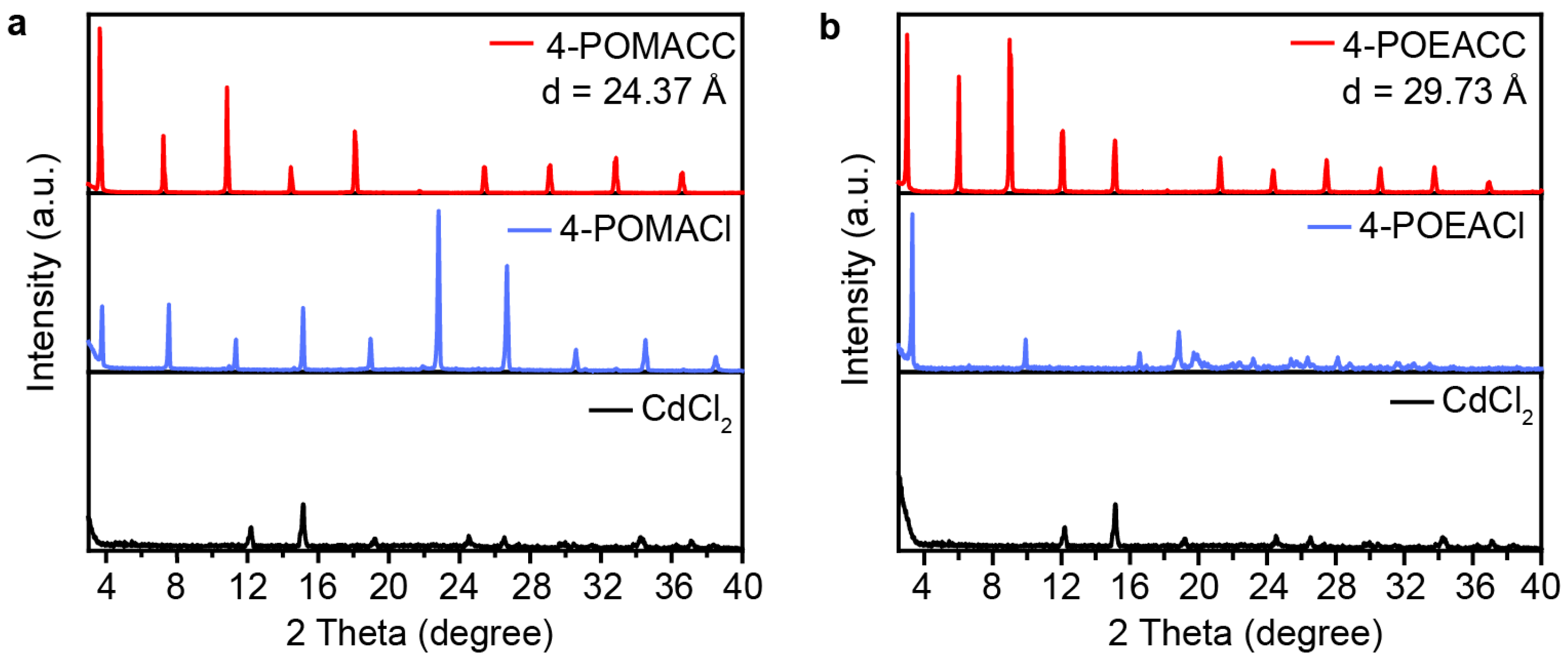
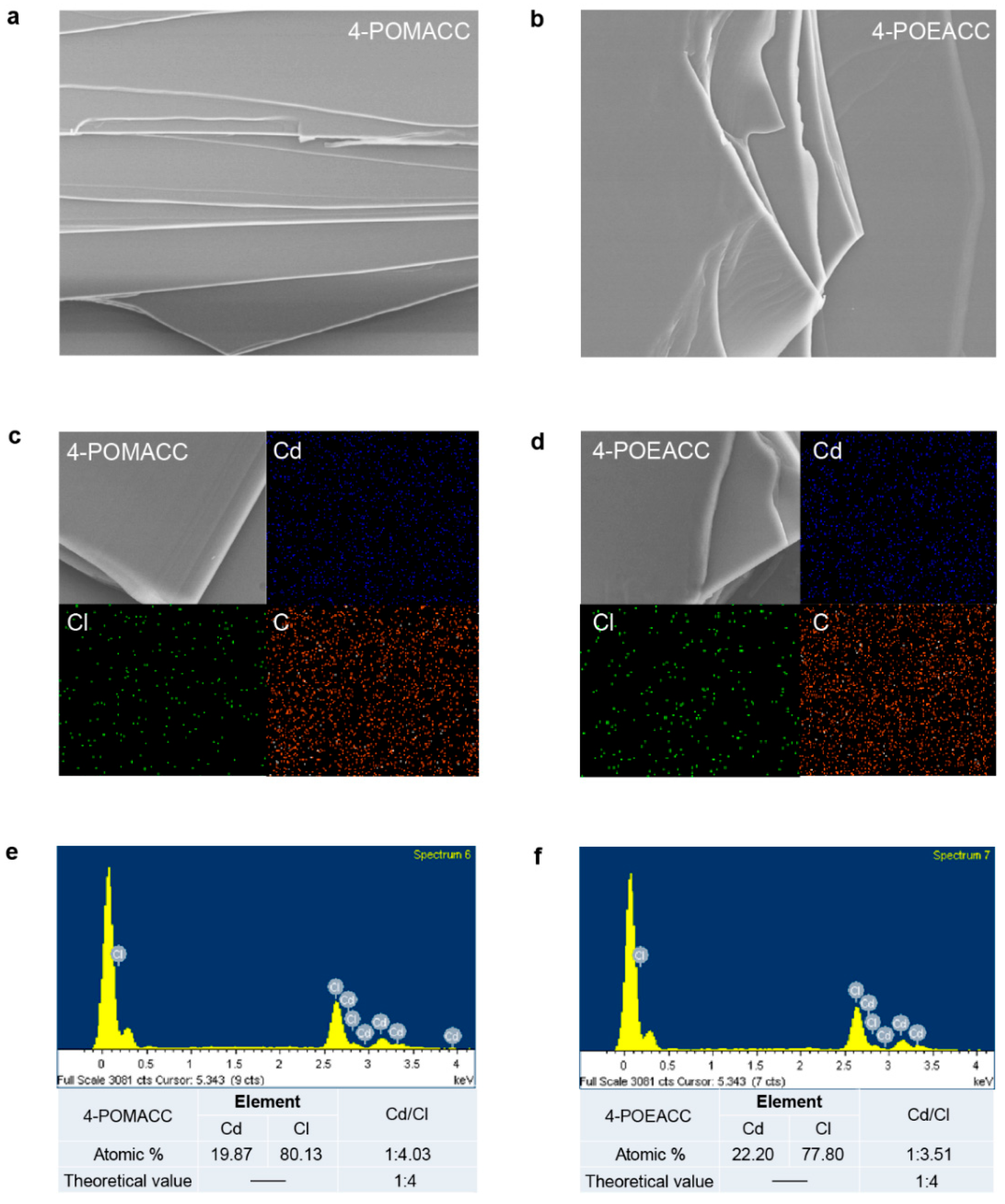


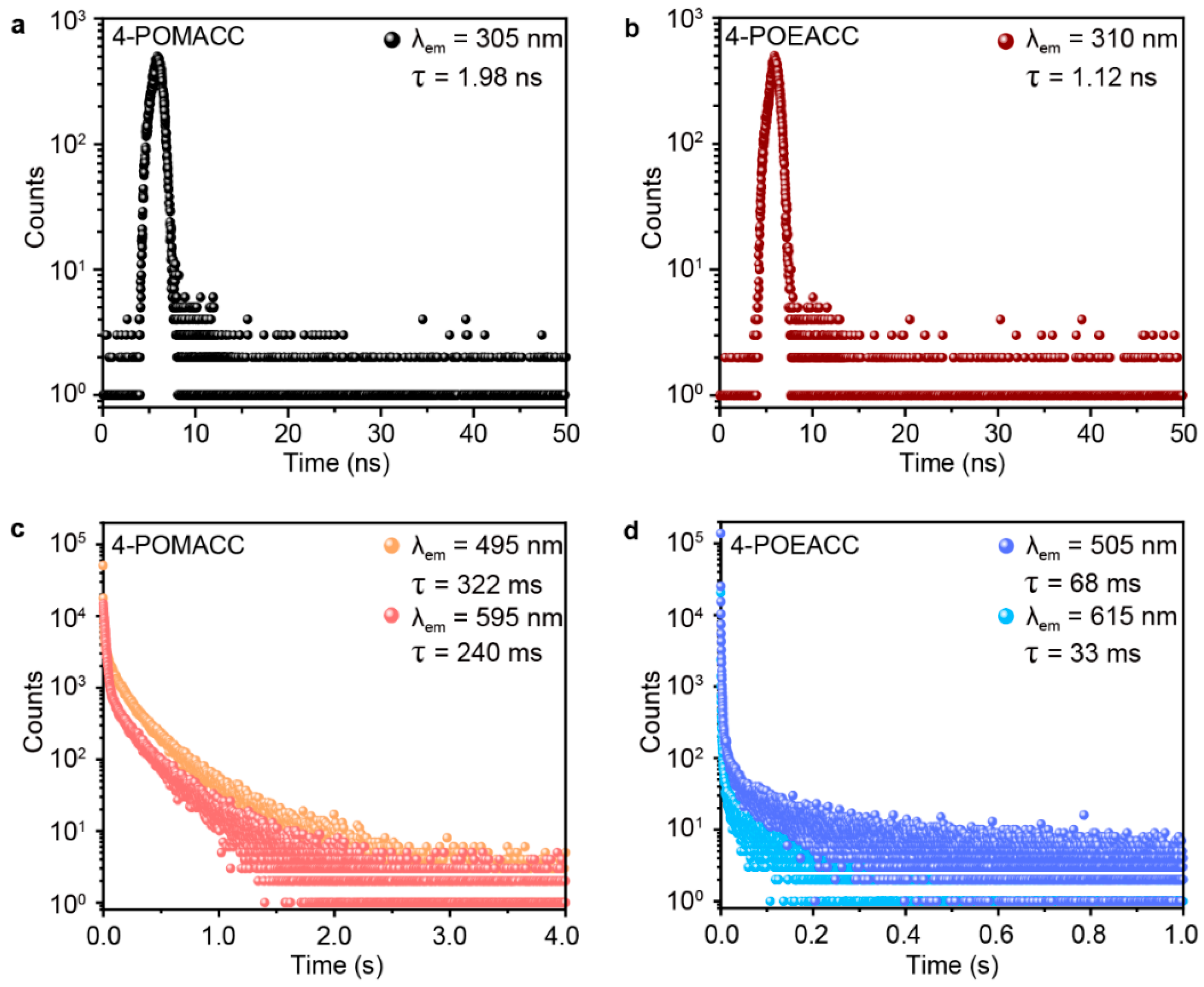
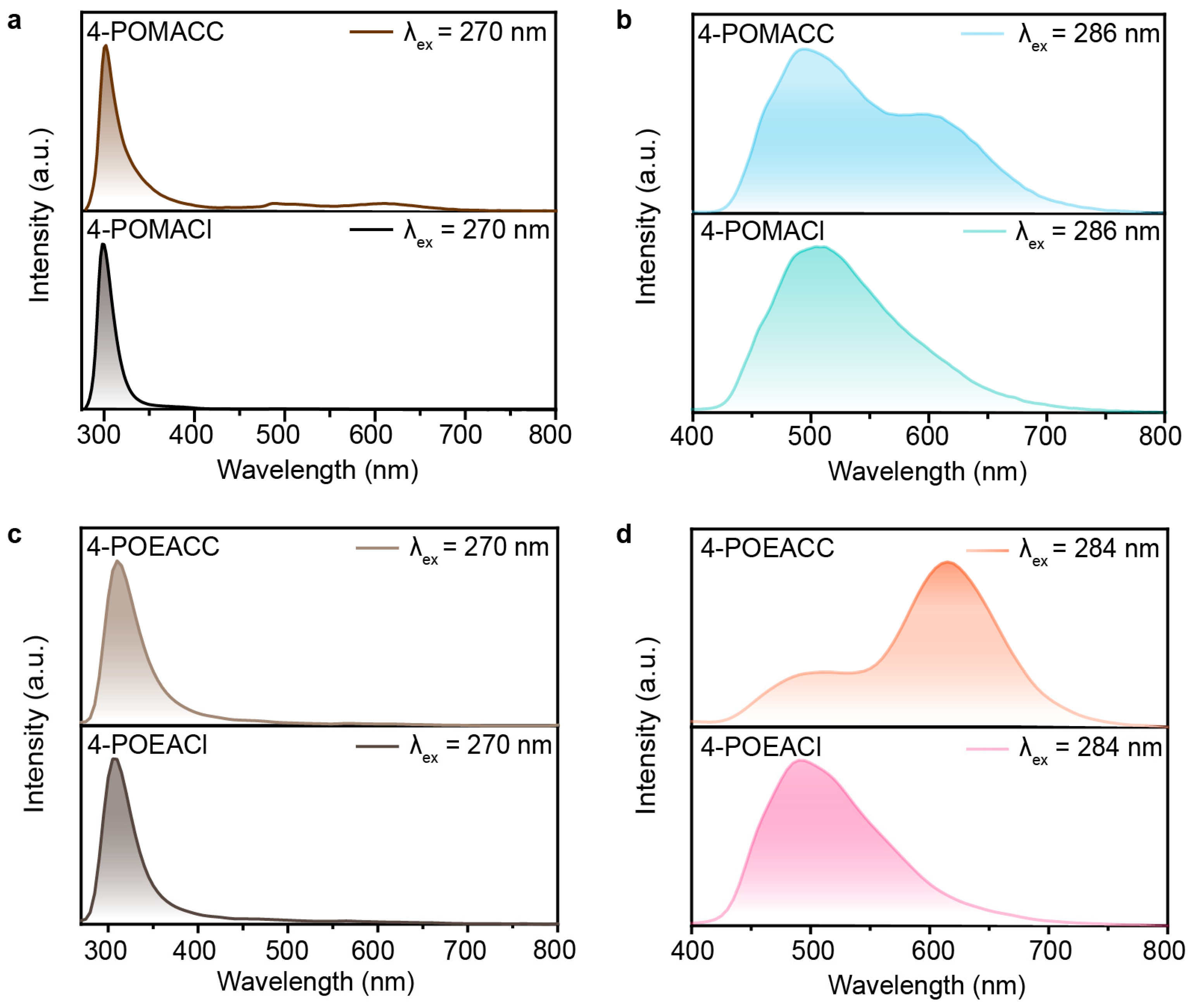
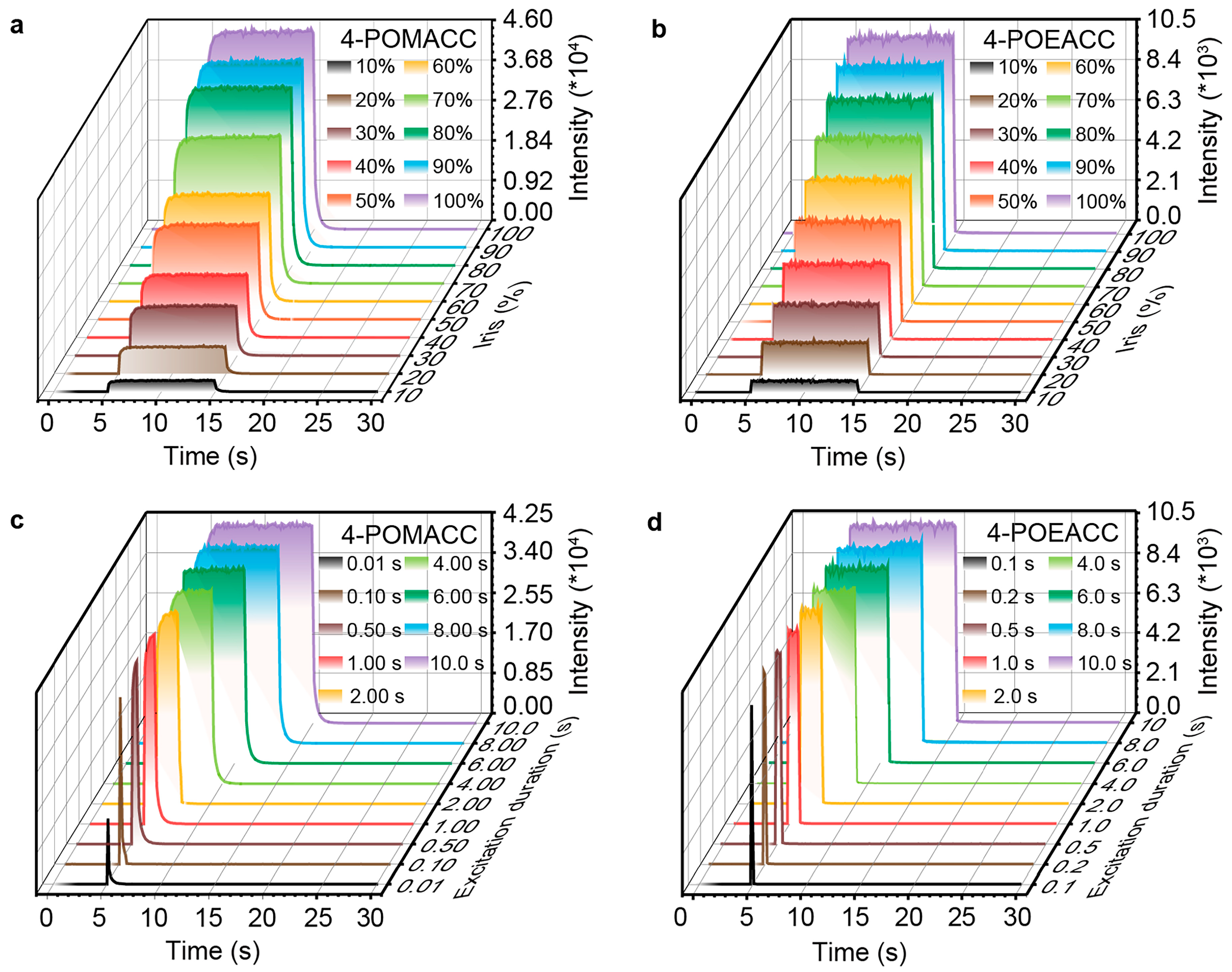
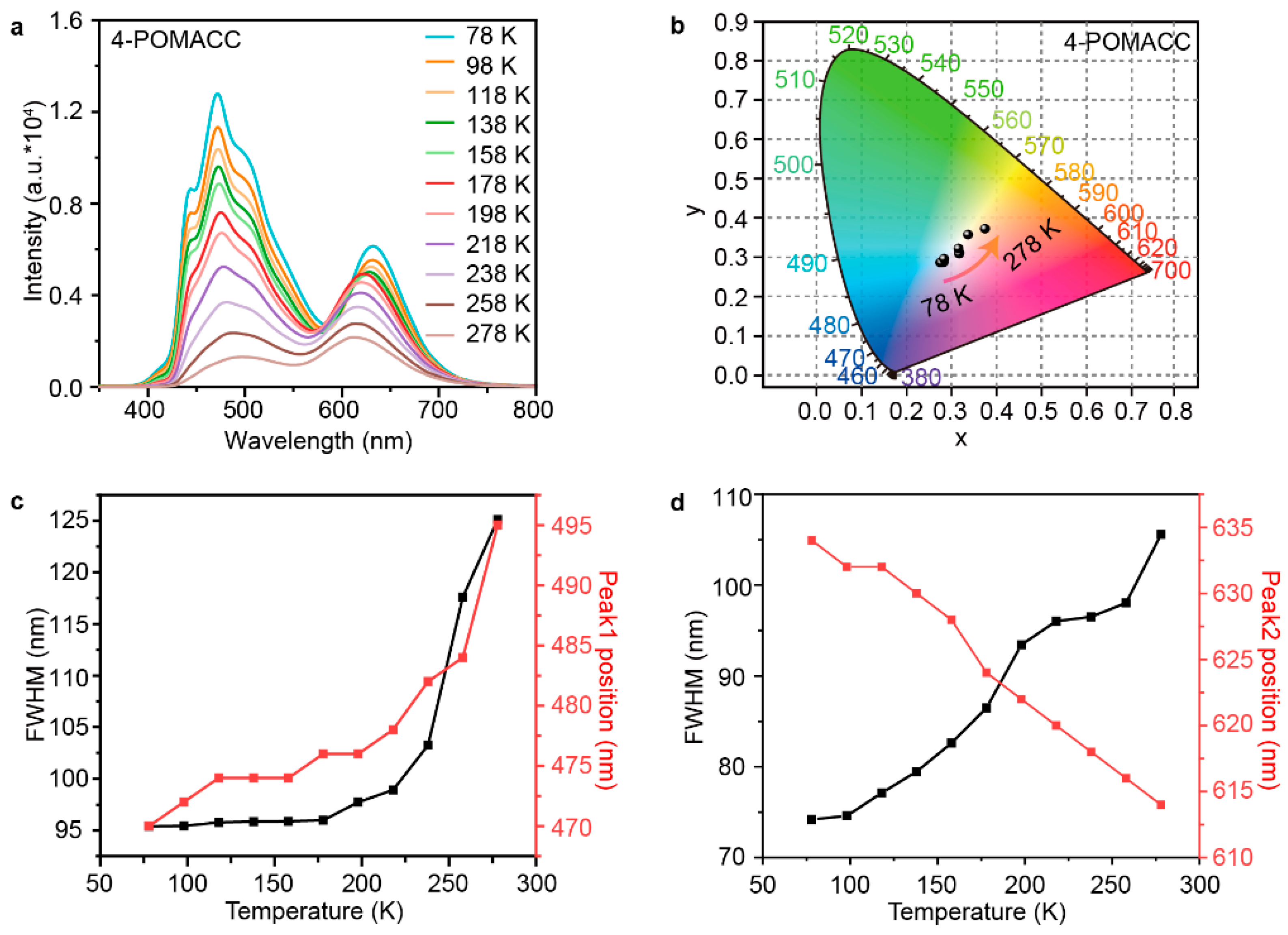
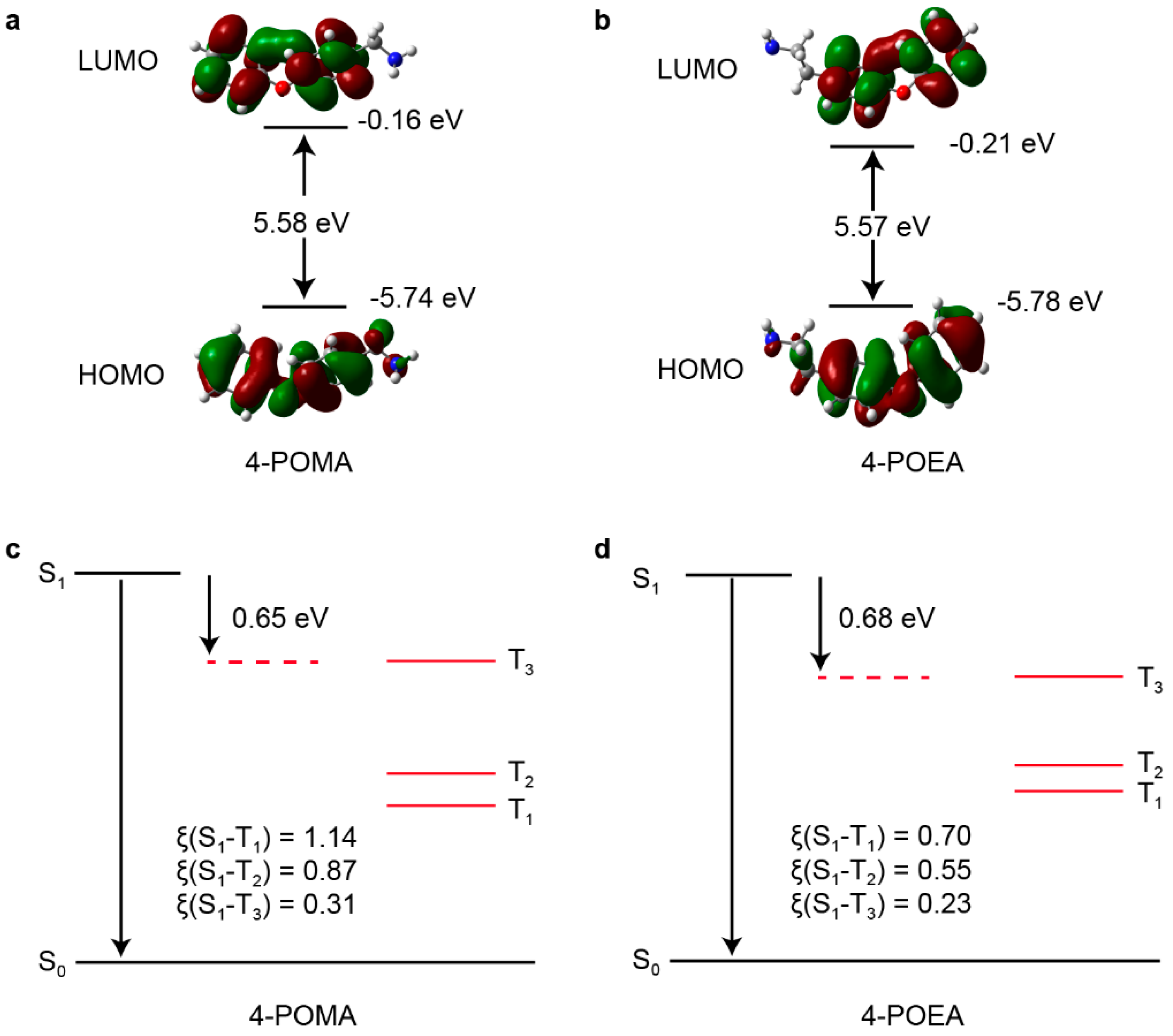

Disclaimer/Publisher’s Note: The statements, opinions and data contained in all publications are solely those of the individual author(s) and contributor(s) and not of MDPI and/or the editor(s). MDPI and/or the editor(s) disclaim responsibility for any injury to people or property resulting from any ideas, methods, instructions or products referred to in the content. |
© 2025 by the authors. Licensee MDPI, Basel, Switzerland. This article is an open access article distributed under the terms and conditions of the Creative Commons Attribution (CC BY) license (https://creativecommons.org/licenses/by/4.0/).
Share and Cite
Wang, S.; Zhu, H.; Sheng, M.; Shao, B.; He, Y.; Liu, Z.; Li, M.; Zhou, G. Achieving Ultralong Room-Temperature Phosphorescence in Two-Dimensional Metal-Halide Perovskites by Tuning Alkyl Chain Length. Inorganics 2025, 13, 108. https://doi.org/10.3390/inorganics13040108
Wang S, Zhu H, Sheng M, Shao B, He Y, Liu Z, Li M, Zhou G. Achieving Ultralong Room-Temperature Phosphorescence in Two-Dimensional Metal-Halide Perovskites by Tuning Alkyl Chain Length. Inorganics. 2025; 13(4):108. https://doi.org/10.3390/inorganics13040108
Chicago/Turabian StyleWang, Suqin, Hui Zhu, Ming Sheng, Bo Shao, Yu He, Zhuang Liu, Min Li, and Guangtao Zhou. 2025. "Achieving Ultralong Room-Temperature Phosphorescence in Two-Dimensional Metal-Halide Perovskites by Tuning Alkyl Chain Length" Inorganics 13, no. 4: 108. https://doi.org/10.3390/inorganics13040108
APA StyleWang, S., Zhu, H., Sheng, M., Shao, B., He, Y., Liu, Z., Li, M., & Zhou, G. (2025). Achieving Ultralong Room-Temperature Phosphorescence in Two-Dimensional Metal-Halide Perovskites by Tuning Alkyl Chain Length. Inorganics, 13(4), 108. https://doi.org/10.3390/inorganics13040108







